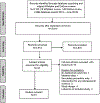Intimate Partner and Sexual Violence Prevention Among Youth: A Community Guide Systematic Review
- PMID: 34772564
- PMCID: PMC9125790
- DOI: 10.1016/j.amepre.2021.06.021
Intimate Partner and Sexual Violence Prevention Among Youth: A Community Guide Systematic Review
Abstract
Introduction: Intimate partner violence and sexual violence are widespread and often occur early in life. This systematic review examines the effectiveness of interventions for primary prevention of intimate partner violence and sexual violence among youth.
Methods: Studies were identified from 2 previous systematic reviews and an updated search (January 2012-June 2016). Included studies were implemented among youth, conducted in high-income countries, and aimed to prevent or reduce the perpetration of intimate partner violence or sexual violence. In 2016-2017, Guide to Community Preventive Services (Community Guide) methods were used to assess effectiveness as determined by perpetration, victimization, or bystander action. When heterogeneity of outcomes prevented usual Community Guide methods, the team systematically applied criteria for favorability (statistically significant at p<0.05 or approaching significance at p<0.10) and consistency (75% of results in the same direction).
Results: A total of 28 studies (32 arms) met inclusion and quality of execution criteria. Interventions used combinations of teaching healthy relationship skills, promoting social norms to protect against violence, or creating protective environments. Overall, 18 of 24 study arms reported favorable results on the basis of the direction of effect for decreasing perpetration; however, favorability for bystander action diminished with longer follow-up. Interventions did not demonstrate consistent results for decreasing victimization. A bridge search conducted during Fall 2020 confirmed these results.
Discussion: Interventions for the primary prevention of intimate partner violence and sexual violence are effective in reducing perpetration. Increasing bystander action may require additional follow-up as effectiveness diminishes over time. Findings may inform researchers, school personnel, public health, and other decision makers about effective strategies to prevent intimate partner violence and sexual violence among youth.
Published by Elsevier Inc.
Conflict of interest statement
No financial disclosures were reported by the authors of this paper.
Similar articles
-
Surveillance for Violent Deaths - National Violent Death Reporting System, 50 States, the District of Columbia, and Puerto Rico, 2022.MMWR Surveill Summ. 2025 Jun 12;74(5):1-42. doi: 10.15585/mmwr.ss7405a1. MMWR Surveill Summ. 2025. PMID: 40493548 Free PMC article.
-
Body image, obesity, and sexual coercion: Impacts on depression among students at a Nigerian university.PLoS One. 2025 Jun 17;20(6):e0319308. doi: 10.1371/journal.pone.0319308. eCollection 2025. PLoS One. 2025. PMID: 40526711 Free PMC article.
-
Psychological violence in dating relationships among adolescents: A systematic review and meta-analysis of prevention programs.Prev Med. 2022 Jun;159:107053. doi: 10.1016/j.ypmed.2022.107053. Epub 2022 Apr 22. Prev Med. 2022. PMID: 35469775
-
Home treatment for mental health problems: a systematic review.Health Technol Assess. 2001;5(15):1-139. doi: 10.3310/hta5150. Health Technol Assess. 2001. PMID: 11532236
-
Correlates of Intimate Partner Violence Victimization and Perpetration in Adolescents and Young Adults in Sub-Saharan Africa: A Systematic Review.Trauma Violence Abuse. 2024 Apr;25(2):1168-1183. doi: 10.1177/15248380231173428. Epub 2023 May 25. Trauma Violence Abuse. 2024. PMID: 37226506
Cited by
-
Postdigital Bystanding: Youth Experiences of Sexual Violence Workshops in Schools in England, Ireland, and Canada.Behav Sci (Basel). 2025 Jan 18;15(1):81. doi: 10.3390/bs15010081. Behav Sci (Basel). 2025. PMID: 39851885 Free PMC article.
-
Unpacking the consequences of adolescent dating violence victimization: Adult victimization and perpetration across intimate and non-intimate contexts.J Res Adolesc. 2025 Sep;35(3):e70068. doi: 10.1111/jora.70068. J Res Adolesc. 2025. PMID: 40827706 Free PMC article.
-
Trend and spatial pattern of intimate partner rape notifications against women in Northeast Brazil (2013-2022).Rev Bras Epidemiol. 2024 Jun 14;27:e240030. doi: 10.1590/1980-549720240030. eCollection 2024. Rev Bras Epidemiol. 2024. PMID: 38896650 Free PMC article.
-
Secondary and Tertiary Prevention for Adolescent Dating Violence: A Systematic Review.Trauma Violence Abuse. 2024 Dec;25(5):3938-3950. doi: 10.1177/15248380241265384. Epub 2024 Jul 30. Trauma Violence Abuse. 2024. PMID: 39077987 Free PMC article.
-
[Addressing sexual violence in health services].Aten Primaria. 2024 Nov;56(11):102837. doi: 10.1016/j.aprim.2023.102837. Epub 2024 Jan 11. Aten Primaria. 2024. PMID: 38212181 Free PMC article. Spanish.
References
-
- The National Intimate Partner and Sexual Violence Survey (NISVS) . National Center for Injury Prevention and Control, Centers for Disease Control and Prevention. https://www.cdc.gov/violenceprevention/data-sources/nisvs/index.html. Updated July 19, 2021. Accessed February 1, 2018.
-
- Breiding MJ, Basile BK, Smith SG, Black MC, Mahendra RR. Intimate partner violence surveillance: uniform definitions and recommended data elements, version 2.0. Atlanta, GA: National Center for Injury Prevention and Control, Centers for Disease Control and Prevention; 2015. https://www.cdc.gov/violenceprevention/pdf/ipv/intimatepart-nerviolence.pdf. Published 2015. Accessed February 1, 2018.
-
- Basile KC, Smith SS, Breiding MJ, Black MC, Mahendra RR. Sexual violence surveillance: uniform definitions and recommended data elements, version 2.0. Atlanta, GA: National Center for Injury Prevention and Control, Centers for Disease Control and Prevention; Published 2014. https://www.cdc.gov/violenceprevention/pdf/sv_surveillance_-definitionsl.... Accessed February 1, 2018.
-
- Eaton AA, Stephens DP. Chapter 10 - adolescent dating violence among ethnically diverse youth. In: Wolfe DA, Temple JR, eds. Adolescent Dating Violence: Theory, Research, and Prevention. Miami, FL: Elsevier Academic Press, 2018:233–260. 10.1016/b978-0-12-811797-2.00010-4. - DOI
Publication types
MeSH terms
Grants and funding
LinkOut - more resources
Full Text Sources
Medical
Miscellaneous


